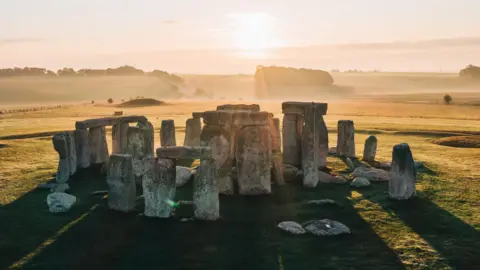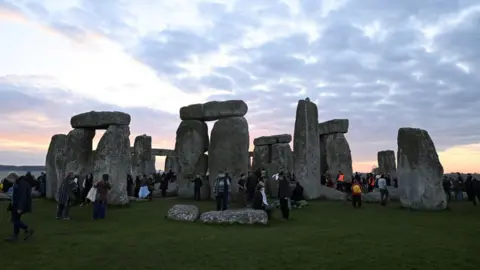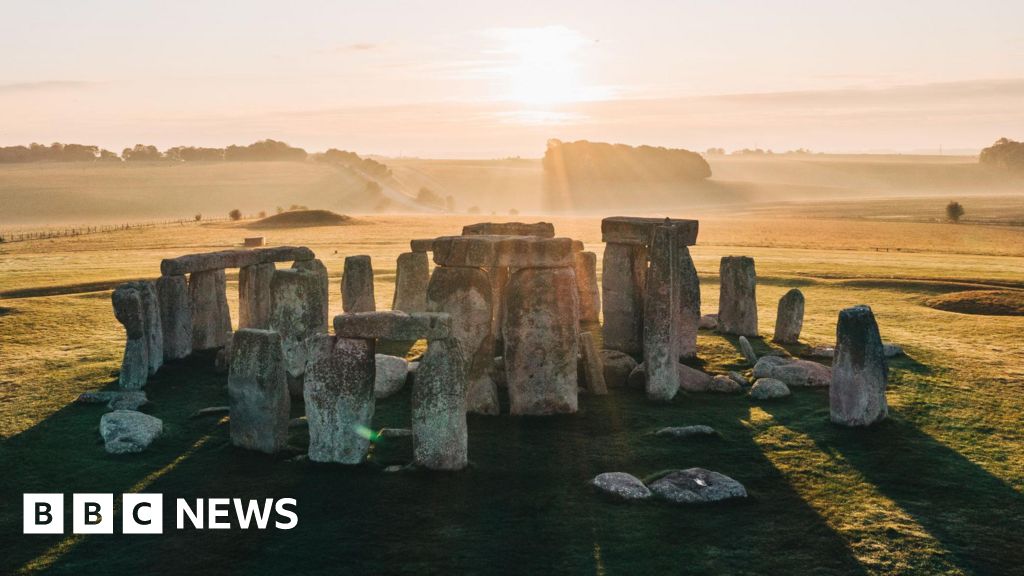 Getty Images
Getty ImagesNew analysis of a Neolithic cow’s tooth found at Stonehenge shows the animal likely came from Wales, and reinforces theories that cattle helped to transport the enormous stones.
The tooth, from a cow’s jawbone found beside the ancient monument’s south entrance in 1924, was analysed by scientists from the British Geological Society, Cardiff University and University College London.
They sliced it into nine horizontal sections and analysed it for clues about the animal’s diet, environment and movement.
Their work offers evidence for the first time of links between cattle remains at Stonehenge and Wales, at the time when the bluestone megaliths were moved to the site.
“It is another tie between Stonehenge and Wales,” Prof Jane Evans, from the British Geological Society, said.
“You can tell that the animal has been grazing on the Palaeozoic rock, typical of those found in Wales, particularly in and around where bluestones are found,” she said.
While bluestones are also found in the Lake District and Scotland, Prof Evans said the evidence clearly pointed to the animal coming from Wales.
“We’re beginning to see so many connections between Wales and Stonehenge. Not only is it the closest rock, but there are other links as well,” she added.
The study also offers the first new piece of evidence since research from 2018 that the boulders were taken to the ancient site with the help of cattle, rather than being dragged there by humans.
“There’s been no evidence that cattle were used as beasts of burden in the Neolithic, but that changed in 2018 when there was a paper that showed that oxen had structures in their feet that were typical of animals that were pulling additional weight and working of beasts of burden,” Prof Evans said.
“It feeds into this new narrative that cattle were perhaps important as beasts of burden,” she said, adding that cows could be used to carry more lightweight kit.
The jawbone dates back to the monument’s very beginning in 2995 to 2900 BC and was placed in a ritually significant place.
Since its discovery, researchers have speculated about what the animal meant to the population building the monument near Salisbury in south-west England.
The molar, about an inch (2.5cm) tall, would have grown incrementally, with the bottom near the gum the youngest part and the tooth representing six months of life for the animal from winter to summer during its second year.
The researchers were able to measure carbon, oxygen, strontium and lead isotopes from the tooth which revealed changes to the animal’s diet with the seasons and showed seasonal food sources came from different geological areas.
This suggests the cow either moved seasonally or that winter fodder was imported, they said.
The lead isotopes revealed composition spikes during the late winter to spring, pointing to a lead source that was older than the lead in the rest of the tooth, the research found.
“The composition suggests the cow originated from an area with Palaeozoic rocks, such as the bluestones found in Wales, before moving to Stonehenge,” the scientists concluded.
“This is yet more fascinating evidence for Stonehenge’s link with south-west Wales, where its bluestones come from,” said Michael Parker Pearson, professor of British later prehistory at University College London.
He added that it raised the “tantalising possibility” that cattle helped to haul the stones.
 Reuters
ReutersThe scientists also concluded that the cow was likely female and pregnant or nursing during the tooth’s formation
“To me, this was one of the more interesting aspects of the study,” said Prof Evans.
She added the thought that researchers were now looking at a more domestic aspect or practical aspect of how the stones were moved was also “quite a new step”.
Moving the stones from their origins in the Preseli Mountains in west and south Wales to Stonehenge would probably have taken two to four months, she said.
“You’ve got to have food supplies. A turnover of people and animals to help pulling. You’re probably going to have all the domestic requirements of living on the land,” Prof Evans said.
The people moving them may also have been based in Stonehenge for a longer period while the stone was being put in place.
The research has led to more questions about the wider practicalities of the stone movement for the whole community, she said.
“It’s rarely considered that women were involved,” Prof Evans pointed out.
“Surely they’ve got to have been there. And probably as many women as men, and children,” she said. “Making food, providing accommodation, there’s a lot involved.”
Scientists might now try to strengthen their conclusions by providing more evidence of Welsh origins through cattle remains.
“So much research around Stonehenge has been surprising and unpredicted in the last few years,” Prof Evans said. “But now we’re looking at people and animals.”

